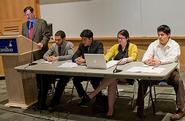
“The youth is a revolutionary demographic,” Benjamin Pena ’12 said at the presentation of a new Arthur Levitt Public Affairs Center poll on May 12. The poll, titled “Immigration and Racial Change: Are All Generations On The Same Page?” was conducted by the James S. Sherman Professor of Government Philip Klinkner and the students of Government 333: Topics in Survey Research.
The survey found that on divisive issues of race and immigration, younger generations (specifically 18-29 year olds) were generally much more open to change and accepting of differences than older generations.
The survey itself was composed of questions posed by the students of Topics in Survey Research. The topics ranged from the integration of immigrants into American society to the perception of president Obama’s religion. Knowledge Networks of Palo Alto, Calif., aided the students in the distribution of the survey, which was administered to a sample size of about 1000 people via the Internet. Percent error was +/- 3 percent for most respondents, but +/- 4.6 percent for the younger generations.
Although the survey stressed that “young Americans display more tolerance for America’s changing racial and ethnic character than do older generations of Americans,” it also noted that the opinions of young Americans do not represent a “monolithic block […] their attitudes and interests are subject to change.”
At the official release of the survey’s findings on May 12, Klinkner and his students took the opportunity to discuss some of their more compelling findings. Sarah Kreiger ’11 found that younger generations are increasingly diverse in terms of ethnicity, which she sees as a partial reason for the more positive views on issues addressed in the survey. Krieger was also very interested in the partisan divisions that the survey uncovered.
Partisanship was especially present in responses to a question Kreiger posed about public support for laws that would allow police officers to verify citizenship status. Although the idea for the question stemmed from the recent controversial legislation in Arizona, Kreiger was quick to point out that she phrased the survey question neutrally.
“[I] wanted to avoid mentioning racial bias or Arizona,” she said.
Survey responses indicated that 48 percent of self-identified Democrats supported the policy, while 80 percent of self-identified Republicans did. Kreiger also mentioned that only 27 percent of white Hispanics supported the policy, a result which she categorized as “not surprising” given that such a policy would most adversely affect Hispanic immigrants.
Many of the students posed questions that were directly pertinent to their own ethnic and religious backgrounds. Redwan Saleh ’13, a self-identified “Bengali Muslim-American,” was interested in investigating “Islamophobia and ethnocentrism” in American society. His question centered on survey participant’s support for the construction of a mosque versus a church in their town. This particular question was delivered as a “split sample:” half of the sample was asked how they would feel about the construction of a church, while the other half was asked how they would feel about the construction of a mosque. This technique allows “better [isolation]…of anti-Muslim attitudes.” Regardless of age group, respondents supported the construction of the church more than the mosque. Saleh did point out that younger Americans were comparatively more supportive of the theoretical mosque construction than older Americans.
Younger Americans are consistently more open to multiculturalism than their older counterparts, and are also more optimistic about the future in general, as Caroline Epstein ’13 found. After citing recent data showing that by 2030 the majority of the U.S. population will be non-white, Epstein asked survey participants whether or not this multiculturalism will have a positive impact on the country. The youngest survey demographic consistently responded that the multiculturalism will have a positive impact upon the country, whereas older groups were less likely to be optimistic about the nation’s multicultural future.
The students of Government 333 are themselves a diverse and intelligent group that captures the spirit of the Hamilton community as a whole. With their example, the optimism of the nation’s younger generation is clearly justifiable.
